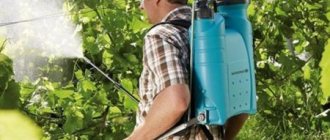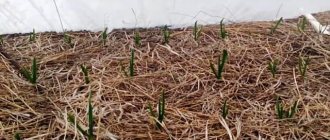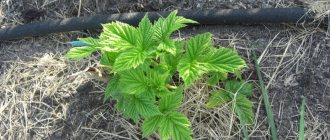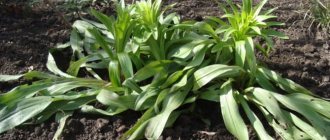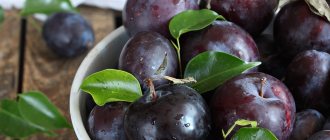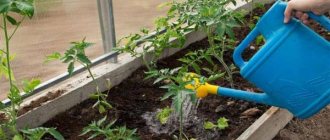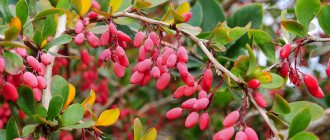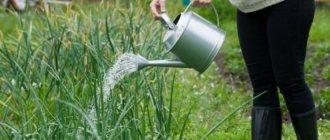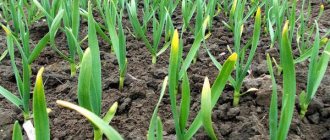Starting watering spring garlic in open ground after planting
Garlic planted in the ground should be watered when its growing season begins. It usually begins in late April or early May and is accompanied by increased leaf growth. In rainy weather, the plant does not require additional moisture.
Garlic especially needs watering with the onset of the growing season.
The need for watering is determined by the soil moisture level, which should be in the range of 75–85%. It can be determined in one of the following ways:
- Using a device that measures soil moisture (moisture meter).
The humidity of the soil is measured with a moisture meter according to the instructions supplied with it.
- Next to the plant in the ground, make a hole approximately 20 cm deep with a spatula, and lower your hand inside. If the soil is slightly moist, then the moisture content is good.
- Use your hand to take out the soil from a depth of 10 cm, squeeze it in your palms, forming a dense lump. When it turns out, the humidity is more than 75%; will immediately disintegrate - humidity 60%, in this case watering will be required.
Garlic does not require watering if the soil taken next to it forms into a dense lump
Do not oversaturate the soil with moisture, which can lead to rotting of the plant. The soil should be slightly moist to the touch, which indicates that the required level of moisture is maintained in it.
Frequency of watering garlic
Garlic needs proper watering so that its heads are large, tasty, and stored for a long time. The frequency of watering is as follows:
- During the period from the emergence of seedlings to the formation of cloves (beginning of May to the end of June), this crop requires good moisture, so it is watered abundantly, wetting the soil to a depth of about 30 cm. During this time, watering is done once a week.
- With the active development and maturation of garlic heads, watering becomes more frequent. The crop is watered once every 5 days, and in dry hot weather - once every 3 days.
When watering, the water consumption rate per 1 m2 is about 12 liters.
Garlic needs regular watering during its growth period.
General principles when watering onions
Typically, experts advise watering onions two months after planting in the ground. The frequency of watering depends on the weather conditions in the region and soil moisture. But there are some general rules for caring for this crop.
Caring for onions in spring
Onions are usually planted in open ground in our mid-latitudes in early May. The day before planting, you need to thoroughly moisten the bed for future planting. After planting onions, do not water them until the soil dries out. If the weather is rainy and humid, then watering is not required at all.
The frequency of Chespoliv in the spring is dictated by the weather at this changeable time of year. If spring is dry and warm, then you need to carefully monitor the condition of the soil in the garden bed. A lack of moisture for a crop in spring is just as negative as its excess.
Typically, in mid-climatic latitudes in the spring, this crop is watered once a week. Small onion heads do not need a lot of moisture. For watering during this period, a bucket of water per square meter is usually enough.
Onion care in summer, June-August
In summer, a slightly different watering regime is observed, as the crop begins to grow both feathers and bulbs. Starting in June, onions are watered somewhat less frequently than in May. Typically, plants need watering once every ten days. In this case, watering should be more abundant than in spring. For each square meter approximately 10-12 liters of water are consumed.
The same frequency of watering should be maintained until mid-July. During this period, the crop undergoes the greatest growth of bulbs. In order for the bulbs to grow, they require large amounts of water for growth and nutrition. To do this, the bed must be shed to a depth of no less than 15 centimeters.
It is important for gardeners to know how often to water the crop at the end of July in order to maintain the quality of the ripening onions.
The frequency of watering at this time remains the same, but the volume of water must be halved. By the end of the month, the volume of water per square meter of crop planting should be no more than 5-6 liters, so that the subsequently harvested onion crop does not lose its integrity.
Read also: Indeterminate type hybrid for protected soil: Palenka tomatoes
You should completely stop watering the onions approximately three weeks before they are fully ripe. This can be determined by the feathers of the onion - creases appear on them.
Rules for watering onions in open ground
Once you have determined your watering frequency, you should consider proper watering methods.
Since onions are a picky crop and very hardy, watering methods may vary. You can water the plants using a watering hose directly at the root, you can use the drip method or the sprinkling method.
When using the sprinkler method, some precautions must be taken to avoid damaging the plants. To do this, put a watering can nozzle with the smallest holes on the hose. At the same time, the onion feathers will not be damaged or broken, which will make it develop worse.
It is best to water onion beds in the early morning.
Some features of watering onions
Water that is too warm is not suitable for watering onions. Humidity at elevated temperatures often leads to the development of various pathogens, and the bulbs may begin to rot. The most suitable temperature for watering the crop is within 14-18 degrees, not higher.
This watering regime will allow you to get a decent onion harvest, and the bulbs will be juicy and tasty, and also quite large, and most importantly, it will make it possible to increase the keeping quality of the heads.
Gardening experts recommend adding various beneficial substances for onions to the water when watering. In this case, Energen has proven itself to be excellent. This stimulator of growth and development of onion heads and feathers. In addition, this drug can reduce the content of harmful substances in onions such as nitrates. In addition, the use of Energen allows you to increase the yield by 40%. This drug is used in the following way: one Energen capsule is dissolved in a ten-liter bucket of water when watering.
To determine the frequency and volume of watering onions, you must carefully observe the appearance of the crop. If there is pallor of the feather, and besides, the feathers become too watery, then there is clearly waterlogging. In this case, the irrigation regime is changed, the frequency and intensity must be reduced.
If the tips of the onion feathers dry out, this is a signal that the soil is drying out and the plant is not receiving enough moisture.
If you grow onions by feather, how to water them
When growing onions by pen, the watering algorithm remains approximately the same as for growing onion heads. Only the frequency of watering will differ - onions grown for feathers require a little more moisture.
If the spring weather is warm and dry, then the crop is watered not once a week, but two or even three times. In this case, the water consumption should be at least 8 liters per square meter.
To achieve long feather growth, the best way is to water the plant at the root.
When growing onions for harvest in July, watering the plants is carried out almost before the start of harvesting. You can stop watering the onions about five days before pruning. It is not recommended to water longer. Excess moisture will make the foliage excessively watery and brittle, and the storage of such onions will be much worse.
When to stop watering garlic
In order to obtain high commercial properties of garlic and increase the duration of its storage before harvesting, watering of this crop is stopped. The time when the last watering should be done is determined in accordance with the purpose of using garlic:
- if it is intended for current needs, watering is stopped a week before harvesting;
- For garlic that will be stored for a long time, stop watering 3 weeks before harvesting.
The harvest of spring garlic planted in spring occurs from August 20 to September 10, while winter garlic (autumn planting) occurs in July.
To keep garlic well, stop watering it three weeks before harvest.
How and when it is contraindicated to water garlic
In some cases, watering garlic is not recommended, including:
- The average daily temperature drops below 13 °C.
- Watering during the daytime. You should not pour water on garlic during the day, when bright sunlight can negatively affect the wet leaves of the plant and cause them to burn.
- Irrigation with a strong stream of water. If there is strong water pressure, then when watering it can damage the leaves and stems of the plant, which will subsequently lead to a decrease in yield and the possible appearance of a fungal infection. In this regard, it is better to use a watering can rather than a hose to water the garlic.
Strong water pressure from a hose can damage the leaves and stems of garlic, which will lead to reduced yield.
- Watering at a late time. When garlic is watered late, the soil will not have time to dry out before night, which will create suitable conditions for a fungal disease.
- Frequent watering with small portions of water. In such cases, water will not be able to penetrate deep into the soil and will become available only to plant roots, located only in the upper layers of the soil. The garlic will not have enough moisture to form a strong root system that can extract moisture from deep in the soil.
- Water getting on leaves. When watering, you need to try to prevent water from getting on the above-ground part of the crop. Although garlic tolerates such watering well, in hot weather there is a risk of fungal disease.
Watering methods
You can water garlic in several ways - manually, using sprinklers or a drip irrigation system. Each of them has its own advantages and disadvantages.
Sprinkling
Watering is carried out using special installations, which can be purchased in stores for vegetable growers. The advantages of this method are that the volume of water poured out is reduced and it is more accurately distributed over the area of the beds.
The disadvantages of this irrigation option are the following: an increased likelihood of plant infection by infections and fungi due to increased humidity, which results from increased evaporation of moisture from the soil surface. Also, sprinklers depend on water pressure and power supply, so they cannot always function properly.
Modern drip irrigation systems, which can be installed at home, provide the best watering for garden crops. They significantly save water, since it only goes to the plants and is not wasted on irrigating rows, and they do not require human presence during operation.
The disadvantages of the drip system are its high cost, but given that it will be used for several years in a row, the cost of it always pays off.
If desired and materials are available, you can make a drip irrigation system yourself, for example, from plastic bottles. This is a completely suitable budget option for small gardens and summer cottages.
How to water garlic planted before winter
When planting garlic before winter, water it depending on weather forecasts. When rain is expected in the next 3–5 days after planting garlic, you should not water this plant. Otherwise, you can lightly irrigate the ridge. Garlic is watered after planting only in arid regions where there is insufficient soil moisture and it rarely rains. Watering will help the soil adhere tightly to the cloves and anchor the roots in the soil.
With the onset of spring, garlic will receive moisture from melting snow. There is no need to additionally irrigate the plant at this time. As for watering, winter garlic will need it during the growth of leaf mass (in April - May) and in the future it will be the same as for spring garlic.
Watering winter garlic begins from the time it grows green leaf mass.
I had to grow winter garlic. I started watering it when green shoots appeared, about once a week. I stopped watering 20-25 days before harvest. The harvest was always good.
Spring watering of young garlic with salt
The saline solution will help repel pests from plants and saturate the soil with useful minerals.
You will be interested to know: When and how to plant winter garlic in Siberia in the fall
Salt solution for garlic can be prepared according to several recipes:
- To kill root nematodes, a solution is prepared from 50 grams (2 level tablespoons) of salt and 10 liters of water. Two square meters of beds are watered with this amount of saline solution. Watering is repeated after a week and a half.
- To repel onion flies from young garlic, prepare a more concentrated solution and spray it on the leaves. To treat onion flies you will need 250 grams (10 tablespoons) of salt and a ten-liter bucket of water.
After treatment and watering with saline solution, the plants are watered with clean water.
Please note that if the garlic feathers turn yellow in May or June, the plants may have pests. In this case, a saline solution will help scare off and destroy them.
